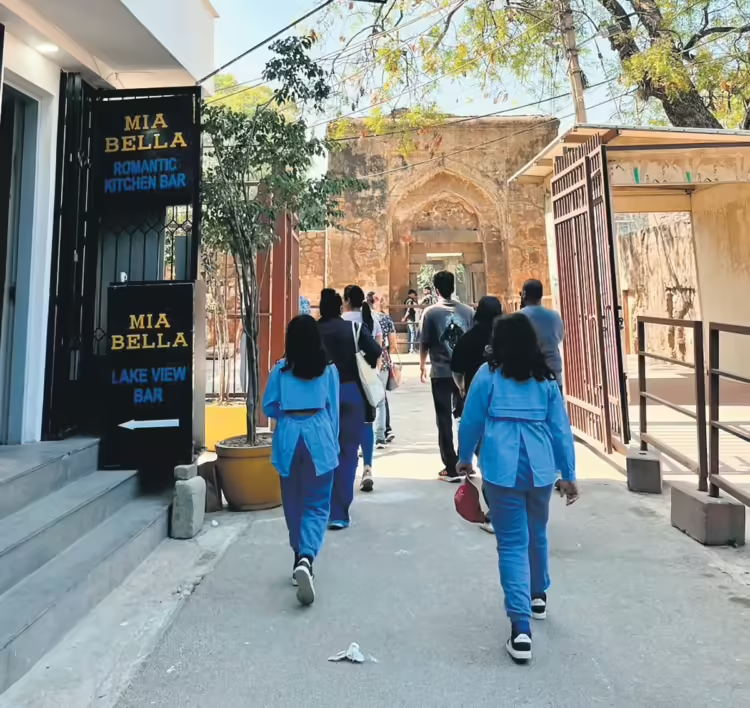An unforgettable stroll through the rich heritage of Delhi
We are at the Hauz-e-Alai reservoir in Hauz Khas on a brilliant, bright day. The reservoir is colored like a bright shamrock, and the surrounding leafy canopy reflects light on it. Under the shady canopy of a massive oak, we stare into its waters, but the peaceful moment is disrupted by an unexpected discovery.

“We are standing above the deceased heads of Mongols,” remarks Srushti Sharma, the walk leader. She explains that the area under our feet is where Delhi Sultan Alauddin Khilji, who ultimately laid the foundation stone of Siri, the second city of Delhi, with Hauz Khas at its epicentre, cut the heads of the invaders in a battle in the 13th century and buried them nearby.
A group of eleven people who had joined the trip to learn about Hauz Khas’ development were intrigued by the somber occurrence. According to Nidhi Bansal, co-founder of Delhi Walks, “this walk is an attempt to explore the lesser-known parts of Delhi, a city comprising eight cities from the medieval age, namely Siri, Lal Kot, Mehrauli, Tughlakabad, Firozabad, Shergarh, Shahjahanabad, and New Delhi.”
#AnyGivenSunday was started by her and Delhipedia creator Ambica Kapoor. In addition, Kapoor says, “the walks will not only focus on one specific monument but also on concepts like urban spaces, their distribution, intangible heritage, oral histories, and other facets of Delhi.”
Transitioning from a rural to an urban village
With India’s independence, the urban hamlet of Hauz Khas started to take shape. Jat farmers occupied the land left by Muslim families who had immigrated to Pakistan after Partition between the 1940s and the 1950s. Places like Hauz Khas, which did not cleanly fit into any one category but yet had a large rural element, were not well understood by committees after 1947, when the government began classifying land in Delhi as either agricultural or residential.
Cafe Pink Pink Cafe
At that time, the government developed the idea of urban villages, which were areas free from construction standards, rules, and bylaws. This allowed unplanned development of residential and commercial space. As globalization and the 1990s arrived, musicians, artists, art historians, academics, socialites, and college students either started to establish their creative outlets or started to patronize them in the neighborhood, which was also one of Delhi’s first urban areas with a “night life.” According to Bansal, she saw the late artist MF Husain strolling about Hauz Khas in his underwear, calling the area’s alleyways “a cave of ideas.”
cradle of style
One wonders what made Hauz Khas a centre for fashion as we make our way through the maze-like streets, past fashion boutiques like Megha and Jigar, Mohitt Sacchdev, and Ogaan. Indian-born designer Bina Ramani deserves the recognition. When she was seeking for a location to start her first business, Once across A Time, in Delhi in 1987, she came across Hauz Khas. She describes in her book, Bird in a Banyan Tree: My Story, how the locals welcomed her when she first went there in the 1980s. It is revealed that Ramani was captivated by the Jat peasants’ exquisite handmade patterns on their clothing, which exemplified their sense of style. The ethnic-chic trend gained popularity because to Ramani’s Hauz Khas shop, and other designers soon opened showrooms.
The cultures of tattoos and graffiti
We are now standing in front of Cafe Pink, beyond the crowded passageways with designer businesses. It is surrounded by two imposing walls covered with eye-catching wall art and graffiti. The wall is a blank canvas covered with drawings of “Azaadi,” sketches of cartoon character SpongeBob, digital posters honoring Pink Floyd’s song “Comfortably Numb,” and classical art figures. However, who has used it? This is the creation of an anonymous urban artist named Daku, who during the 2010 Commonwealth Games in Delhi created mayhem by secretly altering traffic signs and painting graffiti at odd hours of the night.
He and other street painters drew part of this wall at Hauz Khas. Although Daku was seen as a danger to “national security” at the time, his paintings on the walls of Hauz Khas convey important messages about free expression and popular struggles. Some foreign publications have even dubbed Daku “India’s Banksy.” As more tattoo parlors sprung up in Hauz Khas, people’s bodies began to function as canvases just like walls. As our tour guide points out the Garden of Eden, one of the area’s first tattoo parlors, “it became a go-to place for people to convert their passions into entrepreneurial professions due to affordable rents.”
Links to movie theaters
Our next destination is the Hauz Khas fort, which is particularly associated with the film Rockstar. The fort’s ruins were selected by director Imtiaz Ali as the setting for a scene in which Nargis Fakhri and Ranbir Kapoor, feeling rebelliously inclined, take a drink. As a resident of Delhi, I used to go to Hauz Khas often while I was a college student. Only now am I able to put things in perspective,” adds popular Sunflower series actress Radha Bhatt. As we stroll, she is delighted to hear movie tales. “We frequently lament Delhi’s traffic, pollution, and weather, but the city is right in front of us and has a lot to offer,” she continues.
Our stroll ends at the well-known restaurant and bar Hauz Khas Social, where Imtiaz Ali filmed a scene for the film Tamasha. Although the bohemian-meets-ritz appeal of Hauz Khas may have diminished in recent years due to the emergence of urban centers like Gurugram and Greater Kailash, walks like this one, which are jam-packed with fascinating narratives, may teach us about the forgotten facets of Delhi. In the future, among other events, Delhi Walks and Delhipedia want to host walks in Shahpur Jat and Safdarjung Tomb as well as nighttime trails at museums.







